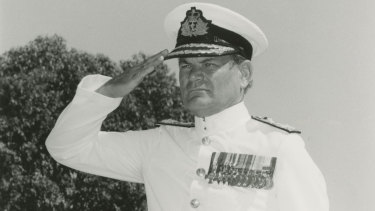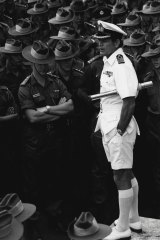July 13, 2020 — 1.05pm
Vice-Admiral Andrew John Robertson was a gunnery officer on HMAS Anzac at anchor off North Korea in 1952 when she came under enemy fire from four 76mm guns hidden in caves some 10 kilometres distant.
Anzac’s guns found the caves’ entrances and a 23-minute duel, in which the destroyer fired 174 rounds, ensued. Robertson, an indispensable part of the ship’s many engagements with enemy forces, was awarded the Distinguished Service Cross for his “calmness and disregard of personal danger”.

Robertson’s 40-year navy career was full of extraordinary achievements.
Long before this conflict, just before the outbreak of World War II in 1939, Robertson, aged 13, joined the Australian Navy as a cadet midshipman and despite his young age, excelled in every aspect of training.Advertisementhttps://ift.tt/2WGQCFD

He received numerous awards for academic achievement, seamanship and sport, culminating with the King’s Medal as the cadet midshipman who displayed the most exemplary conduct, performance of duty and leadership among peers.
After graduating in 1942 at the age of 17, Robertson served in HMAS Australia and HMAS Warramunga, conducting patrols and convoy escort duties in the Coral Sea, around New Guinea and off the east coast of Australia.
In 1944, then midshipman Robertson went to England for his sub-lieutenant’s course, where, true to form, he received first-class certificates in seamanship, navigation, gunnery, torpedoes, signals, air operations and anti-submarine warfare.
The Royal Navy posted him to HMS Kimberley in the Aegean Sea, where the destroyer played a leading role in enforcing the surrender of German forces in the Dodecanese Islands in May 1945.
Returning to Australia later that year, Robertson joined the destroyer HMAS Bataan, which was later deployed to Japan as part of the British Commonwealth Occupation Force. During this time, he walked over the nuclear bomb site at Hiroshima, shortly after the bomb was dropped.
In August 1947, he joined HMAS Swan, which was leading the 20th Minesweeping Flotilla and conducting mine clearance operations in Australia and New Guinea. Minesweeping was time-consuming, arduous and dangerous work, the last demonstrated by the loss of HMAS Warrnambool with four men killed in September 1947.

The following year, Lieutenant Robertson undertook the long gunnery course at HMS Excellent, Whale Island, in England. On return to Australia, he was posted to HMAS Cerberus in Victoria as an instructor at the Gunnery School.
However, he was soon after posted to the newly commissioned destroyer HMAS Anzac, which just three months later would form part of the UN response to the invasion of South Korea.
Immediately on arrival in the waters off South Korea in August 1951, Anzac was put to work and saw active service while conducting aircraft carrier escort duties. Anzac fired 1000 rounds of 4.5-inch ammunition at North Korean targets ashore.
Anzac returned to Australia for a refit in October that year and was back in action in Korea the following year, where the ship again saw active service in providing naval gunfire support. Among numerous engagements with enemy forces, the most legendary fight occurred on November 16, 1952.
Anzac was at anchor protecting the garrison on Cho Do island when fired on by four 76mm guns hidden in caves more than 10 kilometres away. According to naval historian Vice-Admiral Peter Jones, soon rounds from the mountain guns were falling around Anzac.
“In this perilous situation, Anzac quickly slipped her cable, leaving a buoy marking the anchor. Due to the nearby shoals, Anzac was prevented from making a quick seaward escape,” Jones said.
“Fortunately, in a spirited fight, Anzac’s guns found the caves’ entrances and the smoke and dust partly obscured the destroyer from the artillery. A running duel ensued for 23 minutes with Anzac firing 174 rounds with 50 from the enemy falling near the ship.”
As Anzac’s gunnery officer, Robertson was an indispensable part of the ship’s many engagements with enemy forces, and for his service, was awarded the Distinguished Service Cross.
His DSC citation reads: “His calmness and disregard of personal danger when most effectively controlling the armament in a relatively prolonged action against an enemy coastal battery of four guns which hotly and accurately engaged HMAS Anzac on 16 November 1952 was most notable.”
London posting
Following the Korean War, Robertson was appointed the Australian naval liaison officer in London, and then remained in England to undertake the Royal Navy staff course. He was subsequently promoted to commander in 1957.
After returning home, Robertson undertook a wide range of senior appointments including command of the fast troop transport HMAS Sydney taking troops to South Vietnam, commander First Australian Transport Squadron, and commanding officer HMAS Albatross, the Naval Air Station at Nowra, on the NSW South Coast.
It was during this time that Robertson helped facilitate from Albatross the evacuation of more than 350 local residents who had been trapped in their homes after floods inundated the Nowra area.
The lessons learnt from providing this disaster relief were called on four months later, when Albatross aircraft were used in the mass transit of supplies into, and people out of, Darwin after cyclone Tracy in December 1974.
Museum initiated
While commanding Albatross, Robertson initiated the establishment of the Australian Naval Aviation Museum, now the Fleet Air Arm Museum.
Promotion to rear-admiral came in 1980, when Robertson became head of Australian defence staff in the Australian High Commission in London. He was later appointed flag officer Naval Support Command in Sydney.
It was during this time that he was made a Freeman of the City of Sydney for enhancing the bond between the navy and the city.
Robertson was appointed Officer in the Order of Australia in the Queen’s Birthday honours list in 1980 for service to the Royal Australian Navy and the defence force. He retired from the RAN in early 1982 after 43 years of service.
Honorary fellow
Robertson, the driving force behind the conception and creation of the Australian National Maritime Museum, was named the inaugural honorary fellow in 2016.
At age 91, Robertson was the key instigator behind the Windjammer Sailors statue in Darling Harbour and at the time of his death, was a member of 18 organisations or associations, including as patron of the HMAS Sydney Association and Training Ship Sydney for naval cadets.
Maritime museum director and chief executive Kevin Sumption said: “The council and staff of the museum are saddened by the loss of our great friend RADM Robertson. He was one of our earliest champions and we bear daily witness to his legacy in the work we do here. The Windjammers Sailors statue, in the museum’s forecourt, was donated by RADM Robertson and is much loved by our visitors.”
Chief of Navy Vice-Admiral Michael Noonan described Robertson as a role model for what navy officers can achieve in the most demanding of circumstances.
‘Rose to all challenges’
“Rear-Admiral Robertson always sought to fight through obstacles, and rose to all challenges both in war and peace,” Noonan said.
“One of our most admired leaders, his courage under pressure and calm demeanour in the face of adversity has set the benchmark for our navy leaders now, and for generations to come.”
Rear-Admiral Andrew Robertson is survived by his wife Patricia (Pat) and children Angus, Jane, Julia and Bruce.
Lieutenant-Commander Alistair Tomlinson and Tim Barlass
Andrew John Robertson: 1925 -2020
from JC's Navy, Military and Maritime https://ift.tt/3jw0PPh
via IFTTT










No comments:
Post a Comment
How did you like the post, leave a comment. I would appreciate hearing from you all. Best wishes from JC's Naval, Maritime and Military News